Rockpals has created several versions of their 300Wh and 500Wh power stations.
I wanted to compare their current models both to each other to see their differences and to their previous versions to find out what changed.
I have the Rockpals Rockpower 500 (current model) and think it’s a great system that’s also inexpensive compared to its competition.
However, I also have the Jackery Explorer 300, which is similar to the Rockpals 300 model, and I really like how portable it is compared to the larger Rockpals 500.
I’ll start off with the pros and cons of the current Rockpals 300 and 500 and then explain their similarities and differences.
| Model | Pros | Cons |
|---|---|---|
| Rockpals 300 | – Lightweight – Can fit in a backpack – Relatively inexpensive – 30W USB-C PD port – Port covers on AC and car ports | – Average battery cycle life – Slow recharging times from wall, car, and solar – USB-C PD is not as powerful as some competitors |
| Rockpals 500 | – Fast solar recharging (4.2 hrs @ 120W max) – Relatively inexpensive – 45W USB-C PD port – Anderson Powerpole input (compatible with many different solar panels) – Port covers on AC and car ports | – Average battery cycle life – Slow recharging times from wall and car – USB-C PD is not as powerful as some competitors |
The Rockpals 500 is better than the Rockpals 300 because it has almost three times the maximum input power from solar panels (120W vs 45W), a larger battery (505Wh vs 280Wh), and a higher AC output and USB-C PD input/output of 500W vs 300W (continuous) and 45W vs 30W respectively.
| Power Station | Rockpals 300 | Rockpals 500 |
|---|---|---|
| Highest Battery Capacity | X | |
| Most Port Options | X | |
| Highest-Powered AC Ports | X | |
| Highest Solar Input | X | |
| Lightest Weight | X | |
| Cheapest Cost | X |
Below are the specifications of both models. I’ll be explaining most of these specs a bit more, but want to show you exactly what’s similar or different between the two.
| Model | Rockpals Rockpower 300 | Rockpals Rockpower 500 |
|---|---|---|
| Image | ||
| Battery Capacity | 280Wh | 505Wh |
| Battery Cycle Life | 500 cycles to 80% capacity | 500 cycles to 80% capacity |
| AC Ports | 1x AC port (300W continuous, 500W peak) | 2x AC ports (500W continuous, 750W peak) |
| USB Ports | 1x USB-C PD input/output (30W max) 1x USB-A QC 3.0 (5-9V/2A) 2x USB-A ports (5V/3.1A) | 1x USB-C PD input/output (45W max) 1x USB-A QC 3.0 (5-9V/2A) 2x USB-A ports (5V/3.1A) |
| 12V DC Ports | 1x DC car port (12V/10A) 2x DC ports (12V/5A) ^All ports are not regulated | 1x DC car port (12V/10A) 2x DC ports (12V/5A) ^Ports are regulated |
| Recharging Times | AC adapter: 6-7 hrs 12V car adaptor: 6-7 hrs Solar charging @ max input: 6.2 hrs USB-C PD: 9.5-10 hrs AC Adapter + USB-C PD: 4 hrs | AC adapter: 7-8 hrs 12V car adapter: 7-8 hrs Solar charging @ max input: 4.2 hrs USB-C PD: 11-11.5 hrs AC Adapter + USB-C PD: 4.3-5 hrs |
| Weight | 7.7 lbs | 12.3 lbs |
| Dimensions | 10.5 x 5.3 x 8.5 in | 12 x 9 x 6.1 in |
| Price | $230-285 | $400-450 |
| Avg. Cost Per Wh | $0.92/Wh ($257.5/280Wh) | $0.84/Wh ($425/505Wh) |
| Comes With | 1x AC Charging Adapter 1x Car Charger Cable 1x Warranty Card | 1x AC Charging Adapter 1x Car Charger Cable 1x Warranty Card |
| Availability | Available on Amazon | Available on Amazon |
Rockpals 300 vs. 500 – What’s the same?
The most obvious similarity between the Rockpals models is their basic layout. They have different features but they’re subtle.
Both power stations have a sturdy handle, the exact same color scheme, and are rectangular.
But below are the less-obvious features that are shared across both systems.
LCD screen
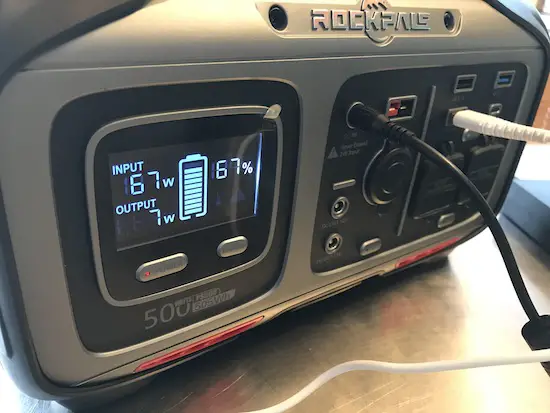
On the left-hand side of both models is the large LCD screen, which shows limited data. Input wattage, output wattage, battery percentage, and a battery status icon are the four main features of the Rockpals 300 and 500.
If your Rockpals is malfunctioning, the LCD also has warning icons that appear in the corners of the screen.
I have yet to see these in action with my Rockpals 500, but if I were to overheat it (for example), a temperature icon would appear on the lower right-hand side of the screen.
Port covers
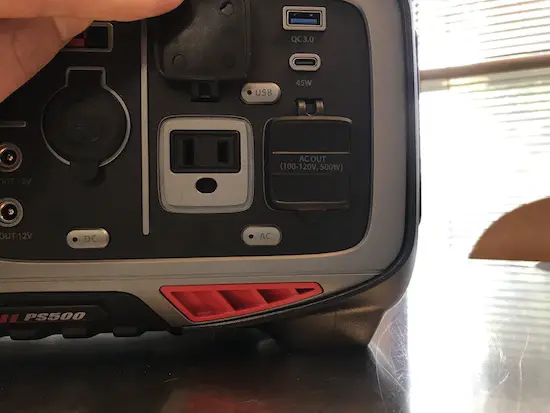
On the 12V car port outputs and AC ports are port covers. The car port cover is hard to get off because it is tightly secured. The AC ports have covers that are easier to remove but still function nicely.
This is not common on portable power stations. Sometimes there will be a car port cover (since it’s the largest port) but most models that you’ll find do not have AC port covers.
USB-A outputs
All three USB-A outputs are exactly the same on the Rockpals 500 and 300. You get one QC 3.0 and two 5V, 3.1A USB-As.
These ports were hard for me to use when I first got my Rockpals 500 because they had to be broken in. After about five or six attempts to use each port, they were easier to plug in and use.
If you want to see more of these subtle features that I found when testing the Rockpals 500, you can read my review here or scroll down a bit to my YouTube video review and test.
Pass-through charging
The Rockpals 300 and 500 both have pass-through charging capabilities via their 12V DC and USB ports. However, you cannot use their AC ports while charging them up.
Using the AC ports while charging up the power station can reduce the battery cycle life of the system.
In larger solar generators like the Titan, you can successfully use pass-through charging (including its AC ports). Larger power stations tend to have this feature but smaller ones usually don’t have this luxury.
Rockpals 300 vs. 500 – What’s different?
AC, 12V DC, & USB-C PD ports
Although the two power stations look similar, there are some pretty significant differences to their output ports.
- AC ports: The Rockpals 300 has an AC port rated at 300W continuous (500W peak), whereas the Rocxkpals 500 model is rated for 500W continuous (750W peak).
- 12V DC ports: The Rockpals 300 model has 12V ports that are not regulated but the Rockpals 500’s 12V ports are regulated.
- USB-C PD ports: The Rockpals 500 has a slightly higher input/output maximum than the Rockpals 300 from USB-C (45W vs 30W).
Input ports
There are three input ports on the Rockpals 500 and two on the Rockpals 300. The one additional input on the Rockpals 500 is an Anderson Powerpole for solar charging.
This is a huge advantage to the smaller model because the Powerpole can take in up to 120W, which equates to 4.2 hours of charging time if you’re using all 120W.
The two ports that both models charge are a DC input and USB-C PD. However, the input wattages differ.
- Rockpals 300: DC input (45W max); USB-C input (30W max)
- Rockpals 500: DC input (72W max); USB-C input (45W max)
Due to their differences in battery size, both models recharge in a similar time period from USB-C, wall, and car charging. The Rockpals 500 actually charges about an hour longer on average via these methods when comparing it to the Rockpals 300.
But from solar charging, the Rockpals 500 can recharge much faster than the Rockpals 300.
- Rockpals 300 solar charging time @ 45W (max): 6.2 hours
- Rockpals 500 solar charging time @ 120W (max): 4.2 hours
How long does it take to charge Rockpals 300W?
The Rockpals 300 takes 6-7 hours to charge from its AC adapter, 12V car charger, and from a Rockpals 100W solar panel. It takes 9.5-10 hours to recharge it from its 30W USB-C PD port and when it’s combined with its AC adapter, it takes four hours to recharge.
- AC Adapter: 6-7 hrs
- 12V Car Adaptor: 6-7 hrs
- ROCKPALS 100W Solar Panel: 6-7 hrs
- USB-C PD: 9.5-10 hrs
- AC Adapter + USB-C: 4 hrs
How do you charge Rockpals power stations?
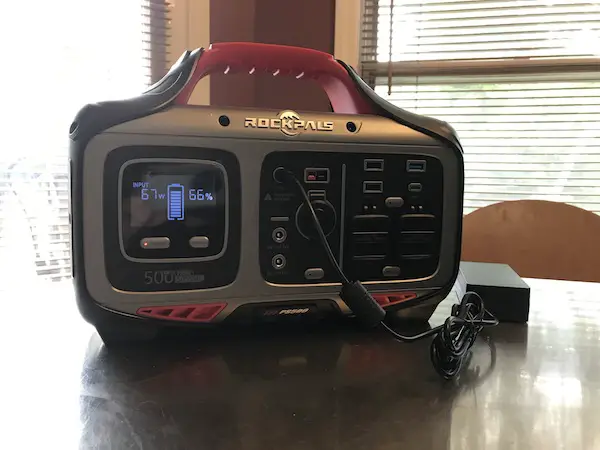
Rockpals power stations charge via solar panels, wall chargers, car chargers, and USB-C PD chargers. For example, the Rockpals 300 charges through a DC input (up to 45W) for solar, car, and wall charging and a USB-C PD port (up to 30W).
The Rockpals 500 charges in a similar fashion but at different input wattages. Its DC input takes up to 72W and this is for wall and car charging. The wall charger specifically recharges the Rockpals between 65-72W.
The Rockpals 500 has an Anderson Powerpole input port that isn’t on the Rockpals 300 model. This is located to the right of the DC input and is meant for solar panel charging. This port can take in up to 120W from solar and is the fastest single charging method.
Battery capacity
With 505Wh of battery, the Rockpals 500 is much larger than the Rockpals 300 model, which has 280Wh.
This can be useful for you if you need more power off the grid, but if you don’t need the additional battery life, it may be better to get the Rockpals 300 since it’s cheaper and more portable than the larger system.
What can the rockpals 500 run?
| Device/Appliance | Port Used | Wattage | Run Time |
|---|---|---|---|
| Small space heater | AC | 425W | 1.07 hrs |
| CPAP machine | 12V DC | 60W | 8.4 hrs |
| Laptop charger | AC | 50W | 9.09 hrs |
| Lamp | AC | 15W | 30.3 hrs |
| Phone charger | USB-A | 10W | 50.5 hrs |
In my video below, I test out the Rockpower 500 (and even use my space heater). This will show you exactly how well it performs as well as some additional insights from my experience.
Weight & dimensions (portability)
The Rockpals 300 weighs 7.7 lbs and is pretty small and easy to carry around. The Rockpals 500 weighs 12.3 lbs and still is easy to carry, but its dimensions make it a little bigger than the Rockpals 300.
- Rockpals 300 dimensions: 10.5 x 5.3 x 8.5 in
- Rockpals 500 dimensions: 12 x 9 x 6.1 in
These measurements show that the Rockpals 500 is only slightly bigger in length, width, and height than the Rockpals 300.
I’ve only carried my Rockpals 500 around short distances, but it is not very heavy or hard to carry.
Price
Ranging between $230-285 depending on coupons, the Rockpals 300 is not expensive for its size compared to similar models. The Jackery Explorer 300 is $300, yet it has similar functionality and battery capacity.
The Rockpals 500 costs $400-450, which is a clear step up from its smaller companion, but it is also a pretty inexpensive option for what it can do.
Check out the pricing of similar models below.
| Solar Generator | Battery Size | Price |
|---|---|---|
| Rockpals Rockpower 500 | 505Wh | $400-450 |
| EcoFlow River Max | 576Wh | $450-500 |
| Goal Zero Yeti 500X | 505Wh | $700 |
| Jackery Explorer 500 | 518Wh | $500 |
Solar panel pairings & recommendations
For the Rockpals 500 model, I recommend the Rockpals 120W panel (link to Amazon). It runs for about $220, which is about $20 more than the 100W model. The additional power from the larger panel will help speed up charging times.
(link to Amazon). It runs for about $220, which is about $20 more than the 100W model. The additional power from the larger panel will help speed up charging times.
If you’d rather save a little money and get the 100W panel, Rockpals has two options available. I recommend the newer RP082 model (link to Amazon) because it comes with a kickstand.
(link to Amazon) because it comes with a kickstand.
The older model doesn’t have one and it makes a big difference in the power output of the panels when you don’t get the correct angle towards the sun.
As for the Rockpals 300, I recommend their 2nd generation 60W solar panel (Amazon). It’s basically the same thing as the 100W panel I recommended for the Rockpals 500 but condensed.
(Amazon). It’s basically the same thing as the 100W panel I recommended for the Rockpals 500 but condensed.
This one has a kickstand, which is not present in the 1st generation model. The reason I recommend this panel and not a larger one is because the Rockpals 300 takes in a maximum of 45W from solar panels.
A typical good solar panel gets about 80% of its rated output on a sunny day, so 80% of 60W is 48W.
Which Rockpals power station is best?
The ideal power station is the Rockpals 500 because it has better overall qualities. It’s not only bigger than the Rockpals 300, but it includes several upgrades, including:
- Better AC inverter
- Better USB-C PD
- Anderson Powerpole input for solar
- Additional AC port
- Regulated 12V DC ports
However, the Rockpals 300 is a great system for its price and not everyone needs as much power as the 505Wh model. Basically, you’re paying more for upgraded performance and longer running times.
Either way, having a backup power source is a great decision, and I hope you got some good information from this post that will guide you to the best power station for your needs.
I’ll include affiliate links to both products below (I make a small commission for every sale I receive).
This last section goes over each model’s previous iterations so you can see their changes over time.
Rockpals 500 – past models & improvements
In the table, you’ll see all of the specs for each Rockpals power station in the 500Wh range. The significant differences I noticed were the output ports and recharging times.
| Model | Rockpals Rockpower 500 | Rockpals 520 | Rockpals 500 (1st Gen) |
|---|---|---|---|
| Image | 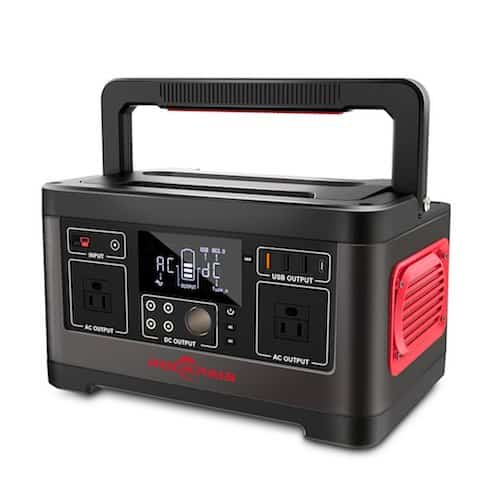 | 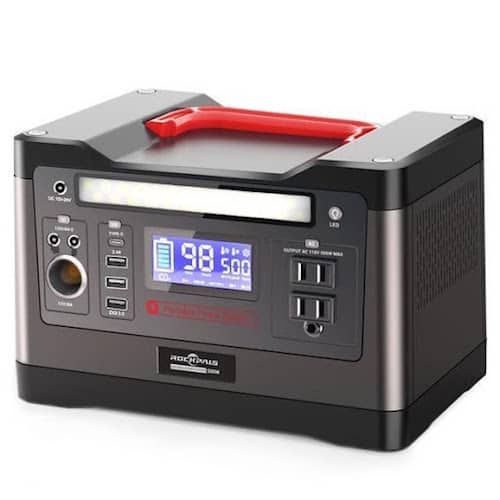 |
|
| Battery Capacity | 505Wh | 520Wh | 540Wh |
| Battery Cycle Life | 500 cycles to 80% capacity | 1,000 cycles to 80% capacity | 500 cycles to 80% capacity |
| Output Ports | 2x AC ports (500W continuous, 750W peak) 2x USB-A ports (5V/3.1A) 1x USB-A QC 3.0 (5-9V/2A) 1x USB-C PD port (45W max) 1x DC car port (12V/10A) 2x DC ports (12V/5A) | 2x AC ports (500W continuous, 1000W peak) 1x USB-C port (18W max) 1x USB-A QC 3.0 2x USB-A ports (5V/3.1A) 4x DC ports (120W; 12A total) 1x DC car port (12V/10A) | 2x AC ports (500W continuous, 1000W peak) 1x USB-C port (18W max) 1x USB-A QC 3.0 2x USB-A ports (5V/2.4A) 2x DC ports (12V/4A) 1x DC car port (12V/8A) |
| Recharging Times | AC outlet: 7-8 hours 12V car adapter: 7-8 hours Solar charging @ max input: 4.2 hours USB-C PD: 11-11.5 hours USB-C PD + AC charging: 4.3-5 hours | AC outlet: 7-8 hours 12V car adapter: 7-8 hours Solar charging @ max input: 5.8 hours | AC outlet: 6-7 hours 12V car adapter: 6-7 hours Solar charging @ max input: 6 hours |
| Weight | 12.3 lbs | 14.33 lbs | 12.13 lbs |
| Dimensions | 12 x 9 x 6.1 in | 12.05 x 7.87 x 6.93 in | 10.24 x 6.7 x 6.82 in |
| Availability | Available on Amazon | Available on Shop Solar Kits | No longer available |
Output port differences over time
- AC ports: The AC ports actually decreased in the latest Rockpower 500 power station by 250 peak watts, but the continuous output was maintained at 500W.
- Standard USB-A ports: The 1st generation model had two 5V/2.4A ports and then was increased to 5V/3.1A in the 2nd and 3rd generation models.
- 12V car ports: The car port improved in the 2nd generation Rockpals 520 to 12V/10A and maintained this rating in the current model.
- USB-C output: Both the 1st and 2nd generation models had an 18W (max) USB-C output, but the current Rockpals 500 has a 45W (max) USB-C PD, acting as an output and input.
Recharging times
AC wall charging and car charging times increased to 7-8 hours for the 2nd and 3rd generation models, but what was improved with each iteration was solar panel recharging time.
Solar charging time @ max input:
- Rockpals 500 (1st Gen): 6 hours
- Rockpals 520: 5.8 hours
- Rockpower 500: 4.2 hours
You can also recharge from the current Rockpals 500’s wall charger and USB-C port simultaneously, which gives a much faster charge than any of the previous models’ options.
LCD screens
A major improvement in the current Rockpals 500 is its LCD screen. Although all three versions had battery status icons and warning symbols, the 1st generation model only didn’t show you the input wattage – so you’d have no idea how much power was going into the power station.
What’s worse is that the 2nd iteration didn’t show the input or output wattage, leaving it up to you to figure out.
The current model has both input and output wattage on its screen – a much-needed improvement.
Rockpals 300 – past models & improvements
| Model | Rockpals Rockpower 300 | Rockpals 330 | Rockpals 300 (1st Gen) |
|---|---|---|---|
| Image |  | 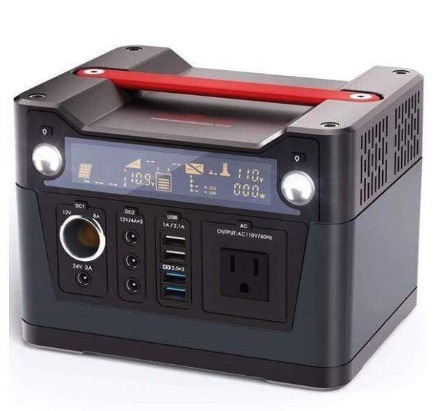 |
|
| Battery Capacity | 280Wh | 289Wh | 280Wh |
| Battery Cycle Life | 500 cycles to 80% capacity | 800 cycles to 80% capacity | 500 cycles to 80% capacity |
| Output Ports | 1x AC port (300W continuous, 500W peak) 1x USB-C PD input/output (30W max) 1x USB-A QC3.0 port 2x USB-A ports 1x 12V/10A car port 2x 12V/5A DC ports | 1x AC port (330W continuous, 700W peak) 1x Wireless charging pad (5W max) 1x USB-C (18W max) 3x USB-A QC3.0 ports 1x 12V/10A car port 2x 12V/5A DC ports | 1x AC port (300W continuous, 600W peak) 2x USB-A QC3.0 ports 2x USB-A ports (5V/3.1A total) 1x 12V/8A car port 1x 24V/3A DC port 3x 12V/4A DC ports |
| Recharging Times | AC Adapter: 6-7 hrs 12V Car Adaptor: 6-7 hrs ROCKPALS 100W Solar Panel: 6-7 hrs USB-C PD: 9.5-10 hrs AC Adapter + USB-C: 4 hrs | AC outlet: 5-6 hours 12V car adapter: 7-8 hours Solar panel (18V max): 5-8 hours | AC outlet: 6-7 hours 12V car adapter: 6-7 hours Solar panel (18V max): 8-9 hours |
| Weight | 7.7 lbs | 8.8 lbs | 7.31 lbs |
| Dimensions | 10.5 x 5.3 x 8.5 in | 8 x 6.1 x 6.5 in | 7.48 x 5.9 x 5.5 in |
| Availability | Available on Amazon | No longer available | No longer available |
Output port differences
- AC ports: The current Rockpals 300 has a lower output rating than its predecessors. Although the continuous power output didn’t change significantly, the surge/peak output lowered to 500W from 700W.
- USB ports: There were many changes to the USB ports as a whole, but clearly the latest model has an advantage over previous versions due to its 30W USB-C PD.
- 12V DC ports: Both the 2nd and 3rd generation models have the same 12V ports, but the 1st generation model had two additional ports. Although it had a higher number of options, the first model had less-powerful amperages compared to its successors.
Recharging times
As a whole, recharging times from car charging and wall charging are similar across all three models.
The biggest differences are the following:
- Solar panel charging: The first iteration of the Rockpals 300 took much longer than future models.
- USB-C charging: Clearly this option only exists on the current model and is an advantage.
- USB-C + AC charging: Also existing only on the latest model, this charging method is by far the biggest advantage because it’s simply faster than all other methods.
For more information, check out some of my Rockpals posts below:
- Current model: Rockpals Rockpower 500 Review (Testing, Pricing, and More)
- 1st & 2nd generation models: Rockpals 500 Review (In-Depth) – Features, Specs, and More
- Rockpals vs Jackery – Product Deep Dive



